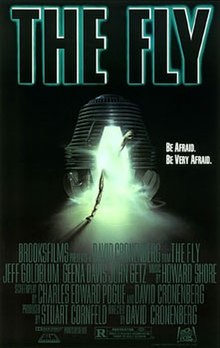
David Paul Cronenberg is a Canadian film director and screenwriter. He is a principal originator of the body horror genre, with his films exploring visceral bodily transformation, infectious diseases, and the intertwining of the psychological, physical, and technological. Cronenberg is best known for exploring these themes through sci-fi horror films such as Shivers (1975), Scanners (1981), Videodrome (1983) and The Fly (1986), though he has also directed dramas, psychological thrillers and gangster films.

Naked Lunch is a 1991 surrealist science fiction drama film written and directed by David Cronenberg and starring Peter Weller, Judy Davis, Ian Holm, and Roy Scheider. It is an adaptation of William S. Burroughs's 1959 novel of the same name, and an international co-production of Canada, Britain, and Japan.
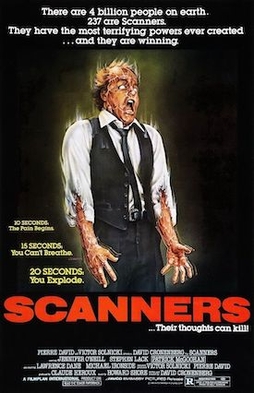
Scanners is a 1981 Canadian science fiction horror film written and directed by David Cronenberg and starring Stephen Lack, Jennifer O'Neill, Michael Ironside, and Patrick McGoohan. In the film, "scanners" are psychics with unusual telepathic and telekinetic powers. ConSec, a purveyor of weaponry and security systems, searches out scanners to use them for its own purposes. The film's plot concerns the attempt by Darryl Revok (Ironside), a renegade scanner, to wage a war against ConSec. Another scanner, Cameron Vale (Lack), is dispatched by ConSec to stop Revok.
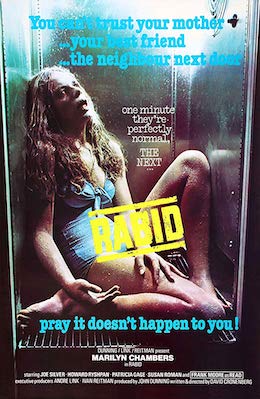
Rabid is a 1977 independent body horror film written and directed by David Cronenberg. An international co-production of Canada and the United States, the film stars Marilyn Chambers in the lead role, supported by Frank Moore, Joe Silver, and Howard Ryshpan. Chambers plays a woman who, after being injured in a motorcycle accident and undergoing a surgical operation, develops an orifice under one of her armpits that hides a phallic/clitoral stinger she uses to feed on people's blood. Those she bites become infected, and then feed upon others, spreading the disease exponentially. The result is massive chaos, starting in the Quebec countryside, and ending up in Montreal. Rabid made $1 million in Canada, making it one of the highest-grossing Canadian films of all time. A remake of the same name, directed by Jen and Sylvia Soska, was released in 2019.
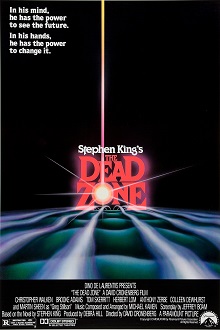
The Dead Zone is a 1983 American science-fiction thriller film directed by David Cronenberg. The screenplay, by Jeffrey Boam, is based on the 1979 novel of the same title by Stephen King. The film stars Christopher Walken, Brooke Adams, Tom Skerritt, Herbert Lom, Martin Sheen, Anthony Zerbe, and Colleen Dewhurst. Walken plays a schoolteacher, Johnny Smith, who awakens from a coma to find he has psychic powers. The film received positive reviews. The novel also inspired a television series of the same name in the early 2000s, starring Anthony Michael Hall, the pilot episode of which borrowed some ideas and changes used in the 1983 film.
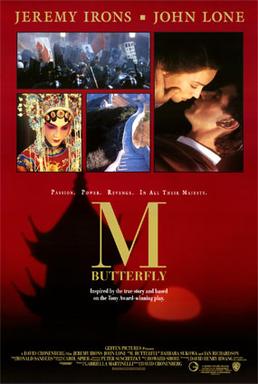
M. Butterfly is a 1993 American romantic drama film directed by David Cronenberg. The screenplay was written by David Henry Hwang based on his play of the same name. The film stars Jeremy Irons and John Lone, with Ian Richardson, Barbara Sukowa, and Annabel Leventon. The story is loosely based on true events which involved French diplomat Bernard Boursicot and Chinese opera singer Shi Pei Pu.

The Fly is a 1958 American science fiction horror film and the first installment in The Fly film series. The film was produced and directed by Kurt Neumann and stars David Hedison, Patricia Owens, Vincent Price, and Herbert Marshall. The screenplay by James Clavell is based on the 1957 short story of the same name by George Langelaan.

The Fly II is a 1989 American science fiction horror film directed by Chris Walas. The film stars Eric Stoltz and Daphne Zuniga, and is a sequel to the 1986 film The Fly, itself a remake of the 1958 film of the same title. Stoltz's character in this sequel is the adult son of Veronica Quaife and Seth Brundle, a scientist who became a human-fly hybrid as a result of an experiment gone awry, played by Jeff Goldblum in the 1986 remake. With the exception of footage of Goldblum from the first film, John Getz was the only actor to reprise his role, with another actress filling the Geena Davis role as Quaife in the opening birth scene. Unlike the previous film, this film received negative reviews.

Dead Ringers is a 1988 psychological thriller film starring Jeremy Irons in a dual role as identical twin gynecologists. David Cronenberg directed and co-wrote the screenplay with Norman Snider. Their script was based on the lives of Stewart and Cyril Marcus and on the novel Twins by Bari Wood and Jack Geasland, a "highly fictionalized" version of the Marcuses' story.

Fast Company is a 1979 Canadian action film directed by David Cronenberg and starring William Smith, John Saxon, Claudia Jennings and Nicholas Campbell. It was written by Phil Savath, Courtney Smith, Alan Treen and Cronenberg. It was primarily filmed at Edmonton International Speedway, in addition to other locations in Edmonton, Alberta, and Western Canada.
Brundlefly or Brundle Fly or variation, can mean:
"The Fly" is a science fiction horror short story by French-British writer George Langelaan. It was published in the June 1957 issue of Playboy magazine. It appeared in SF The Year's Greatest Science-Fiction and Fantasy, Dell First Edition B119, 1958. It was first filmed in 1958, and then again in 1986. An opera of the same name by Howard Shore premiered at the Théâtre du Châtelet, Paris, in 2008. The short story "The Fly" is included in Langelaan's short story collection Out of Time (1964).
George Langelaan was a French-British writer and journalist born in Paris, France.

Ronnie Rocket is an unfinished film project written by David Lynch, who also intended to direct it. Begun after the success of his 1977 film Eraserhead, Lynch shelved Ronnie Rocket due to an inability to find financial backing for the project. Instead, he sought out an existing script on which to base his next film, settling on what would become 1980's The Elephant Man. Lynch returned to Ronnie Rocket throughout the 1980s but by the following decade had stopped considering it to be a viable prospect.
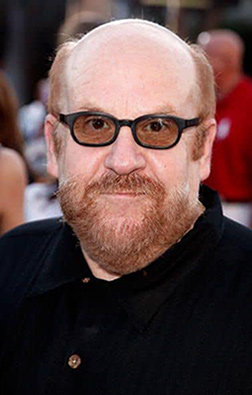
Stuart Cornfeld was an American film producer. He was business partners with Ben Stiller in the company Red Hour Productions.

Jeffrey Lynn Goldblum is an American actor and musician. He has starred in some of the highest-grossing films, such as Jurassic Park (1993) and Independence Day (1996), as well as their sequels.
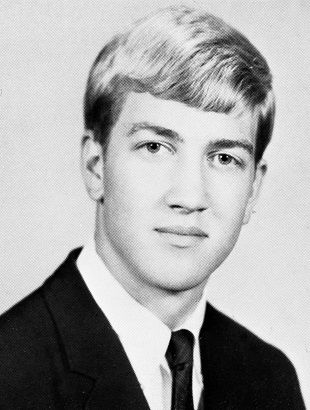
David Keith Lynch is an American filmmaker, painter, television director, visual artist, musician and occasional actor. Known for his surrealist films, he has developed his own unique cinematic style, most often noted for its dreamlike imagery and meticulous sound design. The surreal and, in many cases, violent elements in his films have earned them a reputation as works that "disturb, offend or mystify" general audiences.
Brundle is a surname. Notable persons with that name include:

The film series of The Fly is a sequence of science fiction-horror films, consisting of an original series started in 1958 and a remake series made in the 1980s. The first film of the series, The Fly, was produced and distributed by 20th Century Fox in 1958 as a colour film. The two following black and white sequels, Return of the Fly and Curse of the Fly, both produced by Associated Producers, were released in 1959 and 1965 respectively. The original film was remade in 1986, The Fly directed by David Cronenberg. The remake film received the Academy Award for Best Makeup in 1987. Its sequel, The Fly II, was released in 1989. All five films within the series were distributed by 20th Century Fox.
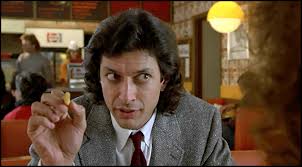
Dr. Seth Brundle, also known as Brundlefly, is a fictional character and the tragic hero in David Cronenberg's 1986 remake of The Fly. He is played by Jeff Goldblum. Brundle was the third of Goldblum's "nerdy scientist" roles and is one of his most famous roles to date.
